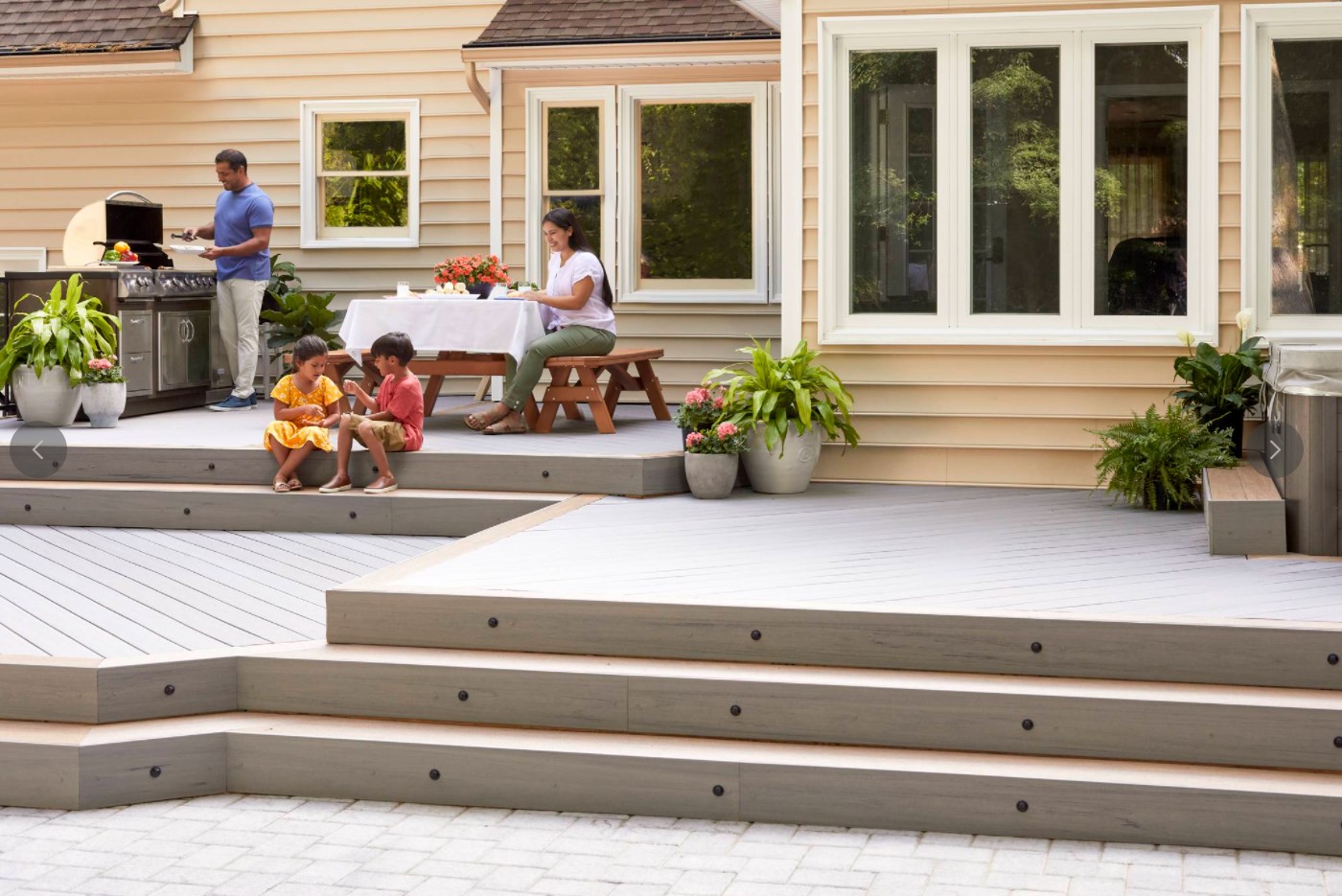So you’re ready to build a deck — congratulations! We’re guessing you already have some ideas about size, space and design. But have you thought about the benefits of composite vs. wood for your new deck?
Since it first came on the deck-building scene, composite decking has grown in popularity despite its traditionally higher cost than standard pressure-treated natural wood. The 2020-21 lumber shortage, however, has caused wood decking costs to skyrocket, closing the cost gap and making choosing between composite and wood more about benefits and less about cost.
Why choose composite decking? Let’s explore the 4 key benefits of composite vs. wood for your new deck:
Composite Decking Benefit #1: Maintenance
Don’t like upkeep? Composite decking is virtually maintenance-free.
With the exception of annual cleaning with soapy water or a power washer, composite decking doesn’t need sanding, staining, painting or sealing to stay picture-perfect. On the flip side, a wood deck requires regular attention every 2 to 5 years — in addition to keeping up with nail pops, chips, warping and scratches that can happen with time, weather, and wear and tear.
Wood deck upkeep is a to-do item you’ll need to add to your home’s maintenance budget on the regular. If you do deck upkeep yourself, wood decking maintenance is much more time- and labor-intensive than composite decking, and supplies will make a dent in your wallet every few years. If you’re not a DIYer, consider the additional costs to regularly hire out the upkeep work.
Composite Decking Benefit #2: Durability
When it comes to durability, composite decking outperforms wood — hands down.
Composite decking holds its own, it doesn’t fade in the sun and won’t stain from the likes of grease, mildew, rust, soot, sap, algae and leaves. Its superior moisture resistance means it won’t rot or warp with sun or harsh weather exposure like wood decking can. It’s more scratch-resistant, so it holds up to wear and tear from furniture, pets and more. If you’re worried about termites, composite decking is more resistant to those pesky destructors. Lastly, most composite decking is treated to resist mold and mildew, which keeps your deck cleaner and helps it last longer.
So how much more durable is composite decking than wood decking? Most well-constructed and properly maintained wood decks will last between 10 and 30 years. The less maintenance you do, the shorter life span your wood deck will have. On the other hand, composite decking can last as long as 50 years — and with fewer maintenance requirements over that time.
Composite Decking Benefit #3: Design
Thinking outside the box? Composite decking has two distinct design perks.
Design is all about details. When it comes to deck building, weight matters. Composite decking is lighter than wood decking, giving you more flexibility in the engineering and overall design of your deck based on what its supports can hold. Composite boards also come in longer lengths than standard wood lengths — up to 20 feet vs. up to 16 feet. The result is a deck design with fewer seams, depending on your dimensions, of course.
 Composite Decking Benefit #4: Comfort & Safety
Composite Decking Benefit #4: Comfort & Safety
Feet prefer composite decking.
Keep all those footsies happier without the worry of splinters that can result from wood decking — composite decking just doesn’t splinter. It also stays cooler in the heat, which is important for your pets’ feet as well as your peoples’. Finally, composite decking is more slip-resistant than wood decking, meaning a reduced risk of dangerous falls when surfaces are wet from dew, rain, pool water, hot tub splashes, spilled drinks, overfilled plants, overzealous sprinkler heads — even water balloons!
The Cost of Composite Vs. Wood Decking
Let’s talk budget. For decades composite decking came with a higher price tag, and though it could be offset over time considering lower maintenance costs and longer-lasting durability, many people just weren’t interested in the higher up-front cost. The recent lumber shortage has been a game-changer, evening the playing field between the two.
In the past, the cost of a composite deck was nearly twice the cost of a deck built with standard pressure-treated natural wood. Today that cost gap has shrunk considerably. Lumber costs are as much as double today what they were before the national shortage. Despite the fact that in some markets the costs may not have risen that high, the price gap has still narrowed. Current predictions keep lumber costs above pre-pandemic levels for the next 1 to 2 years.
With the narrower cost gap, that brings us back to benefits driving the decision between composite and wood. To recap the benefits of composite vs. wood for your new deck: Composite decking is more durable, keeps feet safer and more comfortable, requires less maintenance and can even have a positive impact on your deck design. The choice between the two appears to be a no-brainer.
At Archadeck, count on our design experts to help you customize your deck to your lifestyle and budget and create an outdoor living area that’s uniquely you. Our local owners use only premium products and trained, licensed contractors, and are backed by Archadeck’s exacting standards, professional code of conduct and three decades of proven experience as North America’s largest deck, porch and patio builder. Contact your local Archadeck today to get started.